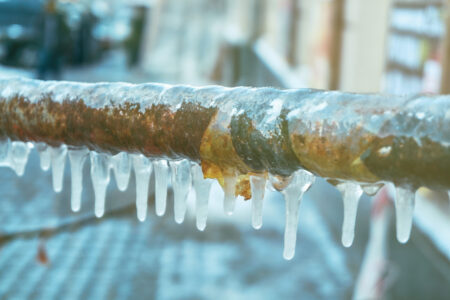How to Prevent Frozen Pipes
Filed under: Uncategorized
 As the temperature drops across the Greater Philadelphia area, a silent threat puts many homes at risk for extensive damage: frozen pipes. Those seemingly insignificant lines running within your walls, under your sinks, and in your basement carry warm water to every faucet and appliance in your home, and when they freeze, you could find yourself with a burst pipe, flooding, and a hefty repair bill.
As the temperature drops across the Greater Philadelphia area, a silent threat puts many homes at risk for extensive damage: frozen pipes. Those seemingly insignificant lines running within your walls, under your sinks, and in your basement carry warm water to every faucet and appliance in your home, and when they freeze, you could find yourself with a burst pipe, flooding, and a hefty repair bill.
Fear not, homeowners. Here at Fosh Plumbing & Heating Inc., we’re dedicated to keeping your pipes flowing, no matter what the temperature reads. Below, we’ve compiled a list of winter-proofing tips to ensure your pipes don’t freeze this winter.
How to Beat the Freeze
A little proactive prep goes a long way in preventing frozen pipes. Here are a few tips to help protect those pipes:
- Insulate exposed pipes – Pipes in your attic, crawl spaces, basements, and garages are especially susceptible to freezing. Insulate these vulnerable pipes with foam sleeves.
- Seal the leaks – Check for cracks or gaps around pipes where cold air can seep in. Caulk or seal these areas with a waterproof sealant, ensuring your home stays draft-free and your pipes remain warm and intact.
- Disconnect outdoor hoses – Drain any remaining water from your outdoor hoses and store it indoors to prevent freezing in the pipes.
- Open cabinet doors – Allow warm air to circulate around the pipes in your cabinets. These under-sink spaces get surprisingly cold.
- Turn up the thermostat – Try not to let your indoor temperature dip below 55 degrees Fahrenheit. A consistent, slightly warmer temperature will help keep your pipes from freezing.
- Let the faucets drip – While this sounds counterintuitive, a slow, steady drip can prevent pipes from freezing. Choose a faucet on an exterior wall, especially where pipes are most exposed to the cold.
- Don’t skip the shutoff valves – Know where your home’s shutoff valve is. In case of a frozen pipe emergency, you can quickly stem the flow and minimize damage.
How to Thaw Frozen Pipes
Even with the best prevention methods, a pipe might still freeze. Before calling in the professionals at Fosh Plumbing & Heating Inc., you can try thawing the pipe yourself. Here’s how:
- Safety first – Always turn off the water supply to the affected pipe before thawing.
- Gather tools – You can use a hairdryer, heat lamp, space heater, electric heating pad, or warm towels to thaw your pipe.
- Apply heat – Start at the faucet end of the pipe and gradually work toward the frozen area. Avoid using open flames, as this can damage the pipe and pose a fire hazard.
- Keep the faucet open – This allows the melted ice to flow out and prevents pressure buildup.
- Be patient – Thawing a frozen pipe can take time. It’s best to apply heat slowly rather than risk damaging the pipe with excessive heat.
How to Prevent Frozen Pipes With Fosh Plumbing & Heating Inc.
While these tips can go a long way, even the most diligent homeowner can encounter a frozen pipe in the winter. That’s where Fosh Plumbing & Heating Inc. comes in. Our team of expert plumbers can quickly assess the situation and thaw stubborn ice to get your pipes flowing again. If you find yourself in need of emergency plumbing services from a burst pipe, contact us immediately at (610) 496-5700.








